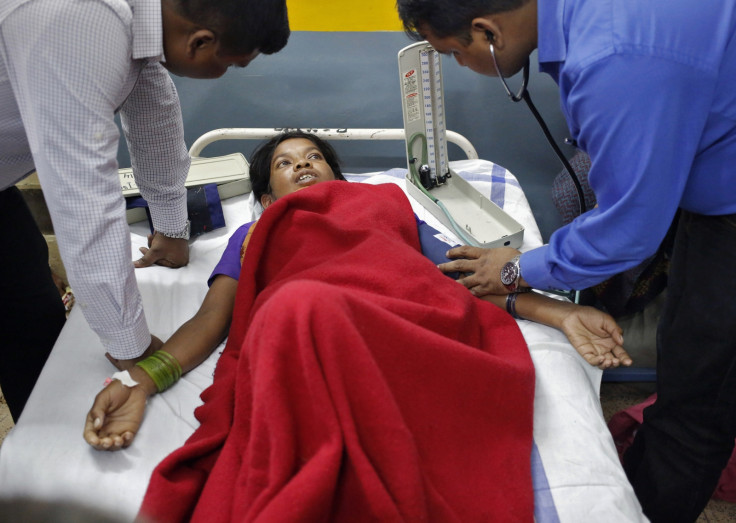India Sterilisation Deaths: Race to Curb Population with Rusty Scalpels and Spurious Medicines?

When it comes to India's sterilisation programme, any doctor who has served with the government and been part of these will tell you that the numbers do not really say anything.
"It is quite normal to do around 20-30 procedures," a doctor, who is familiar with the local family planning programme but does not want to be named, told IBTimes UK.
The tubectomy calls for a small incision below the navel, done under anaesthesia, following which the doctor cuts and ties up the tubes, all taking a few minutes from 5-10.
The accused doctor in the current tragedy, R K Gupta, had allegedly conducted 83 surgeries in five hours on November 8, 2014 after which, within a few hours, 12 women died and many admitted to the hospital in Bilaspur district of Chattisgarh.
In neighbouring Takhatpur, 26 tubectomies were done in an hour, taking the number to one every two minutes.
Official guidelines state doctors should spend at least 15 minutes on each operation and perform a maximum of 30 in a day.
There is a lack of hygiene, yes agrees the doctor who does not want to be identified, but that does not translate to doctors dipping into one patient after another with the same blood-stained scalpel.
Rusty scalpels and dingy rooms?
She does not want to speculate on the reason for the deaths but argues that rusty equipment may not be the reason as any infection would take more time to develop than was the case here.
Gupta said he generally took between two and five minutes on each operation, but gave his assistants time to clean scalpels.
"They are dipped in spirit after an operation and then re-used. If I feel it is not working, well, I change it. I do about 10 operations with the same knife."
The medicines were probably the reasons. The health workers gave the women ciprofloxacin, a commonly prescribed antibiotic, and the painkiller ibuprofen after operations.
One of the five doctors who have conducted autopsies told Reuters that the post-mortems were inconclusive and recommended chemical analysis for a clearer picture.
"It is a mysterious case," said the doctor, who declined to be named. "It can be drug toxicity, infection. We believe some mistake has been (made) but it's purely accidental."
Media reports have cited the operation site as a dingy abandoned hospital with inadequate beds and tables. Medical waste lies strewn around most of these centres.
Reports suggest that women were made to lie on the floor after the surgeries. Some of the women may have died of toxic shock because of contaminated surgical equipment, Amar Singh Thakur, Bilaspur's Joint Director of Health, told NDTV.
Sterilisation in India largely means tubectomy with women offered as scapegoats for the measly 'incentive' of Rs 880. Middlemen take away some of this under some pretext or the other.
Low rate of vasectomies
Call it the macho culture, or simply that men fear the prick and prefer to shove their wives on the operating table, but in India vasectomies only make up 2-3% of the sterilisation procedures.
These are much simpler than tubectomies and hardly go too deep into the skin, says the doctor who has been with the family welfare programme.
The incentive is more from the point of compensating for loss of wages, she clarifies, and is all praise for the birth control programme which has largely been successful even in the very backward states of the country.
India with a 1.2 billion strong population is adding on average 18 million every year.
With more than four million Indians sterilised every year, a system of quotas encourages officials and doctors to cut corners in meeting district targets.
Dr Gupta claimed the deaths were not his fault and that the administration pressured him to meet targets.
Operation risk
There is a risk associated with sterilisation as with any other surgical procedure, we are told. This can happen if the patient has not been tested for all health parameters before the operation.
It can also happen with an unexpected haemorrhage or the anaesthesia, notes the doctor.
Sterilisation deaths have been reported from top-end hospitals too.
But according to WHO, death from sterilisation is extremely rare if done properly. This is a clinical science done at quality standards. "India has fantastic and elaborate instructions on what those standards are; so if someone has died of sterilisation, something grave has gone wrong", Kate Gilmore, the Deputy Executive Director, United Nations Population Fund (UNFPA) told the Hindu.
So, what went wrong with the 12 women who died within a short time after the operations? Or with the many more who have died down the years?
For, death from sterilisation is almost commonplace in India. In the five months from April to August 2013, a total of 129 women died after sterilisation in Tamil Nadu. Around 1,434 deaths have occurred due to sterilisation procedures between 2003 and 2012. The year 2009 was the worst with 247 deaths in the same year.
Whatever the autopsies finally reveal, there are many things that need to be addressed, many autopsies of a different kind required. How well-informed were these women of the procedure? Were they coerced? If the government can offer incentives to workers who bring in the numbers for sterilisation, why is it that it cannot ensure minimum standards for the operation and patient care?
Unless these are handled, the numbers game will soar again -- from sterilisations to deaths.
© Copyright IBTimes 2025. All rights reserved.





















